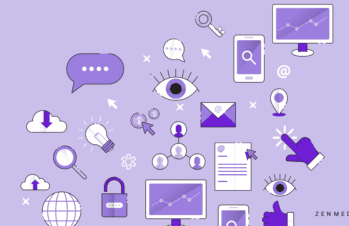They use smart devices at least once a month (but more often—daily). They’re digitally engaged, used to digital channels, and adopting new technologies on a daily basis. They use messaging apps, too, and all of this is changing how they act and make decisions.
If you don’t cater to them—and fast—it could negatively affect your business.
Who are we talking about?
Connected consumers.
What are Connected Consumers?
Connected Consumers are causing quite the conundrum for old-school brands. The digital age has changed how these types of consumers act and make decisions in ways that you won’t find in most B2B marketing books.
Connected consumers are paradoxical.
What does that mean, exactly?
- They’re complex, yet simple.
- They’re independent, yet interconnected.
- They’re digitally native, yet highly hands-on.
- They’re idealistic yet discriminating.
- They’re Gods, yet all too human.
Okay, maybe not Gods—but you get what we mean.
So how do brands navigate the paradox to get to the heart of what’s driving these connected consumers?
What the Connected Consumer Wants
There are two things brands need to understand: How the paradoxes show up as hidden, problematic “gaps” in the purchase history and how to hack these gaps to transform the bumpy road of the purchase journey into a joyride that brings connected consumers happily back to your brand, again and again.
But put yourself in the mind of the connected consumer: From their perspective, they’ve grown accustomed to always being connected, and the more they connect, the more they expect brands to do the same. While the interactions between brands and consumers started small, they now define a lot of everyday experiences.
Brands need to understand these effects and adapt to these modern expectations, find ways to always be “on,” increase personalization while respecting privacy, and even anticipate how the connected consumer’s expectations will continue to change in the future.
Related Reading: The Importance of Connecting With Your Audience in Marketing
Connected consumers fall under four paradoxes. Are you ready to handle each when they approach your business?

Four Key Traits Defining Connected Consumers
Paradox 1: Independent yet Interconnected
Most participants in our survey mentioned sorting through anywhere from 50 to 100 items during their product search. Connected consumers define themselves by their independence and like to take control of their purchase journey, yet they are highly dependent on their relationships with other consumers and brands in determining where they want to go in the first place.
Consumers that fall under this paradox are looking to make informed choices. They scour the internet for top-10 lists that compare products, reviews, and more so that their final choice is educated and the right one for them. In other words, their consumer decision-making and consumer engagement rely on others and their customer experience.
How to hack the gap: Personalize, customize, and curate.
Paradox 2: Idealistic yet Discriminating
Connected consumers hold brands to high ethical standards and idealitscally believe the perfect item or brand is out there.
But their ability to see behind a brand’s image also makes them highly discriminating and suspicious about a brand’s claim to authenticity.
An example: Survey participant Karen created a spreadsheet listing more than 40 different computers to choose from during her search for a new laptop.
How to hack the gap: Walk your talk, tell authentic stories, and get real.
Paradox 3: Digitally native yet highly hands-on
Though many connected consumers are digital natives who grease the wheels of e-commerce, they’re not ready to abandon brick-and-mortar retail. Instead, they’re pioneering the integration of digital space with a physical place.
An example: Survey participant Cory wanted to see the actual lawn mower and compare it to others he was considering. But he didn’t buy in-store. He bought it online so he could use his coupons and picked it up in the store the same day.
How to hack the gap: Online, meet offline: bring digital components into your traditional retail environment.
Paradox 4: Gods, yet All Too Human
In a paradoxical twist of the digital age, consumers now wield god-like technological power and social influence, yet the very conditions that have afforded them this power have also rendered them vulnerable.
An example: Let’s say Jerry is unhappy with his flight getting canceled. He can wait at the airport for the next available flight, or he can take to social media to show his anger by tagging the airline in his posts. He has a large social media following, and hopes his friends will help escalate the problem—but he’s also letting everyone know that he’s not home and is away.
How to hack the gap: Have a healthy respect for the connected consumers’ power while empathically attending to their pain points.
How Brands Can Connect and Engage Connected Consumers
No matter the paradox, connected consumers have one thing in common when it comes to their consumer behavior: They take to the internet to get answers to their questions, do their research, and overall decide what businesses they want to purchase products and services from.
While catering to their digital requests may take time, it’s one of those 27 touchpoints that can’t be ignored. Here are some strategies you can use to market to connected consumers:
Have a strong online presence
This includes having a website that is easy to navigate, active social media accounts, and a strong online reputation.
Use targeted advertising
Connected consumers are often bombarded with ads, so it’s important to make your ads relevant and targeted to the individual viewer. This can be done through the use of cookies, which track a user’s browsing history and allow you to show them ads for products or services that they are interested in.
Offer a seamless online experience
Connected consumers expect a smooth and seamless experience when interacting with your brand online. This includes fast load times, easy navigation, and a secure checkout process.
Use personalization
Personalization can be as simple as addressing a customer by name in an email or as complex as offering personalized product recommendations based on their browsing history. Personalization helps to create a more meaningful and engaging experience for connected consumers.
Provide excellent customer service
Connected consumers expect fast and helpful customer service, whether they are reaching out through email, chat, or social media. Make sure you have the resources in place to meet these expectations.
Want a deeper dive into the practical approaches your brand can implement for reaching, engaging, and retaining connected consumers? Reach out.





